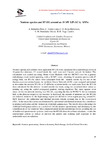JavaScript is disabled for your browser. Some features of this site may not work without it.
Mostrar el registro sencillo del ítem
| dc.contributor | 6207 | es_ES |
| dc.contributor.other | https://orcid.org/0000-0002-7081-9084 | es_ES |
| dc.coverage.spatial | Global | es_ES |
| dc.creator | Bañuelos Frías, Alan | |
| dc.creator | Valero Luna, Claudia | |
| dc.creator | Borja Hernández, Candy Gretel | |
| dc.creator | Hernández Dávila, Víctor Manuel | |
| dc.creator | Vega Carrillo, Héctor René | |
| dc.date.accessioned | 2019-03-14T15:40:25Z | |
| dc.date.available | 2019-03-14T15:40:25Z | |
| dc.date.issued | 2011-09 | |
| dc.identifier | info:eu-repo/semantics/publishedVersion | es_ES |
| dc.identifier.uri | http://localhost/xmlui/handle/20.500.11845/743 | |
| dc.identifier.uri | https://doi.org/10.48779/tvba-9594 | es_ES |
| dc.description.abstract | Neutron spectra and ambient dose equivalent H*(10) were calculated for a radiotherapy room in 16 point-like detectors, 15 located inside the vault room and 1 located outside the bunker. The calculation was carried out using Monte Carlo Methods with the MCNP5 code for a generic radiotherapy room model operating with a 18 MV Linac, obtaining 16 neutron spectra with 47 energy bins, the H*(10) values were calculated from the neutron spectra by the use of the fluence-dose conversion factors. An Artificial Neural Network (ANN) were designed and trained to determine the neutron H*(10) in 15 different locations inside the vault room from the H*(10) dose calculated for the detector located outside the room, using the calculated dose values as training set, using the scaled conjugated gradient training algorithm The mean squared error (mse) set for the network training was 1E(-14), adjusting the data in 99.992 %. In the treatment hall, as the distance respect to the isocenter is increased, the amount of neutrons and the H*(10) are reduced, neutrons in the high-energy region are shifted to lower region peaking around 0.1 MeV, however the epithermal and thermal neutrons remain constant due to the room-return effect. In the maze the spectra are dominated by epithermal and thermal neutrons that contributes to produce activation and the production of prompt gamma-rays. The results shows the using this Artificial Intelligence technic as a useful tool for the neutron spectrometry and dosimetry by the simplification on the neutronic fields characterization inside radiotherapy rooms avoiding the use of traditional spectrometric systems. And once the H*(10) doses have been calculated, to take the appropriated actions to reduce or prevent the patient and working staff exposure to this undesirable neutron radiation | es_ES |
| dc.language.iso | eng | es_ES |
| dc.publisher | Universidad Autónoma Metropolitana | es_ES |
| dc.relation.uri | generalPublic | es_ES |
| dc.rights | Atribución-NoComercial-CompartirIgual 3.0 Estados Unidos de América | * |
| dc.rights.uri | http://creativecommons.org/licenses/by-nc-sa/3.0/us/ | * |
| dc.source | XII International Symposium/XXII National Congress on Solid State Dosimetry September 5th to 9th, 2011. Ciudad de México | es_ES |
| dc.subject.classification | CIENCIAS FISICO MATEMATICAS Y CIENCIAS DE LA TIERRA [1] | es_ES |
| dc.subject.other | Neutron spectrometry | es_ES |
| dc.subject.other | Neutron dosimetry | es_ES |
| dc.subject.other | Radiotherapy | es_ES |
| dc.subject.other | Artificial Neural Networks | es_ES |
| dc.title | Neutron spectra and H*(10) around an 18 MV LINAC by ANNs | es_ES |
| dc.type | info:eu-repo/semantics/conferenceObject | es_ES |
Ficheros en el ítem
El ítem tiene asociados los siguientes ficheros de licencia:

